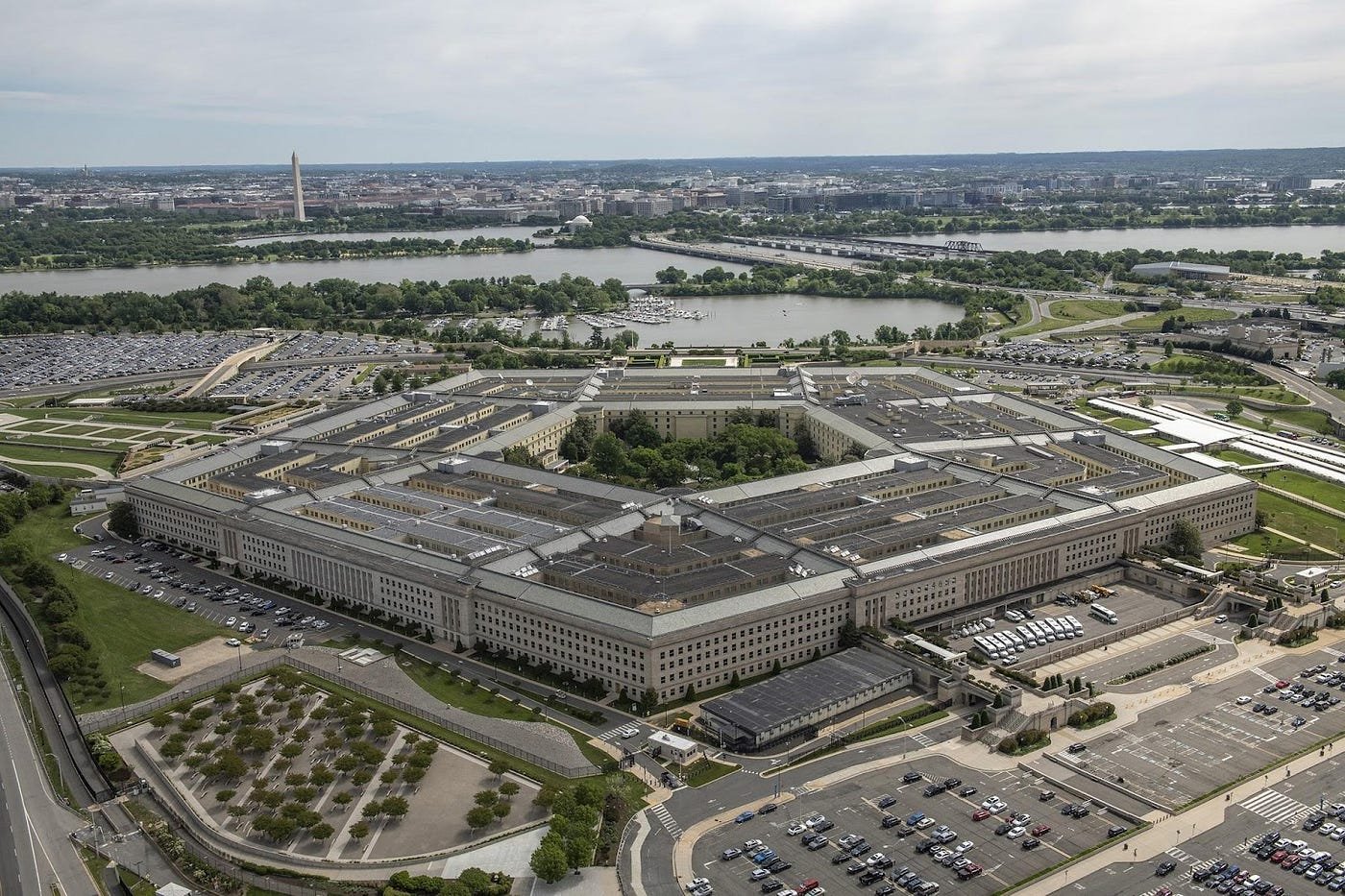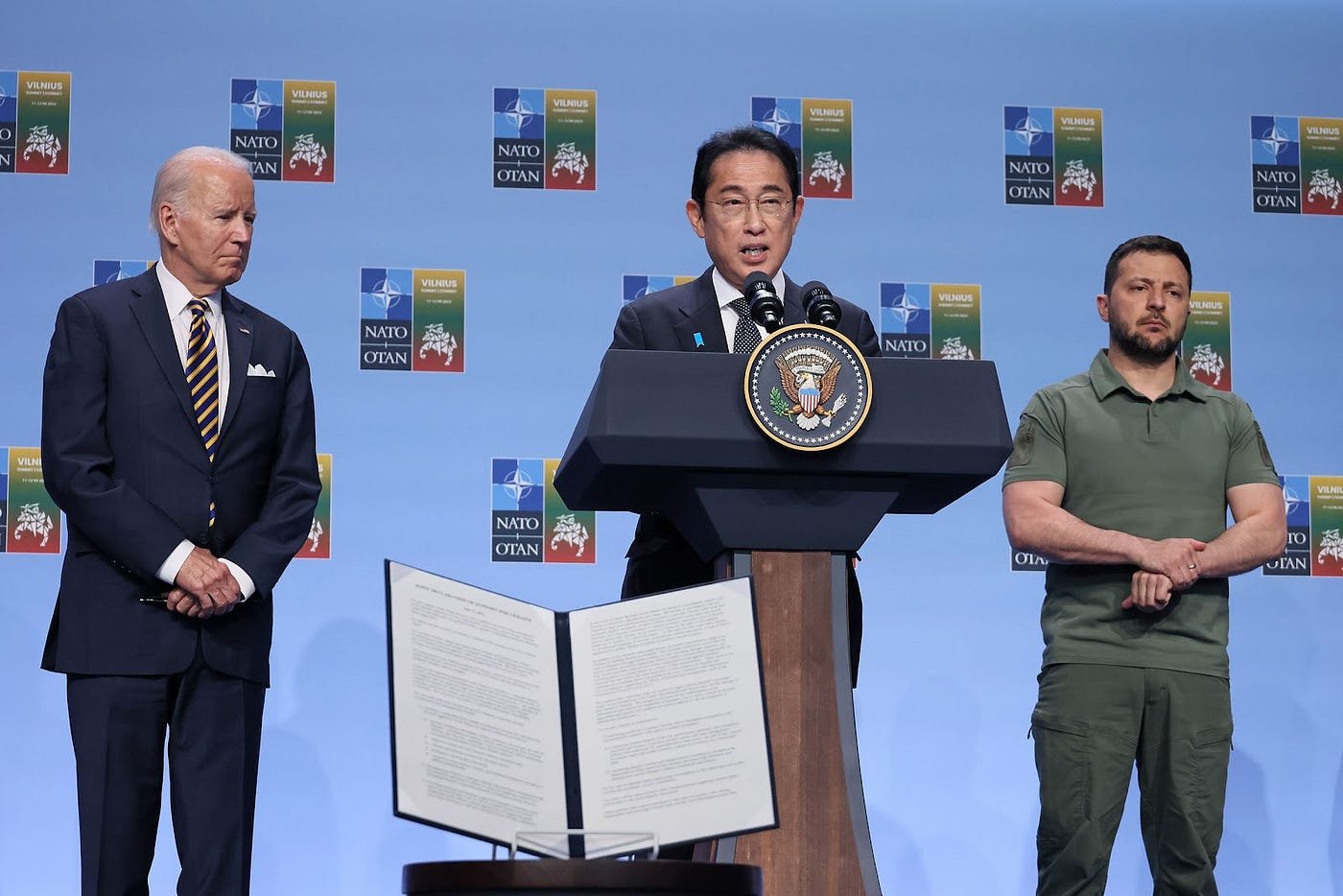Friday News Roundup — July 21, 2023
There are 71 days for Congress to meet the deadline for the annual appropriations bills as laid out by the debt ceiling deal. That September 30th deadline is already casting a chill in July as the sides dig in on Capitol Hill regarding the appropriations process. As we have chronicled, this is not a traditional partisan divide, with the differences between Senate and House looming more prominently. That said, the restive House GOP caucus has delivered its legislative outputs, largely steering right in intra-party disputes thus far. As Ethan Brown chronicles in this week’s roundup, the differences seen in defense proposals — ranging from Ukraine funding to culture war issues — illustrate the complicated coalitions coming together.
Meanwhile as Ukraine funding is discussed as a political football here, the very real life-and-death struggle continues, with Russia now withdrawing from the international grain deal and escalating strikes on Ukrainian agricultural infrastructure. This all comes as the Ukrainian offensive in the south continues to push against dug-in Russian resistance. On the other side of the globe — and perhaps taking in some of the lessons of Ukraine — Taiwan is preparing for the Han Kuang island-wide defense exercise from July 24–28.
In The Hill this week, Joshua Huminski provided an update on the state of the U.S.-UK “Special Relationship”. Breaking Defense also featured Joshua’s analysis of European discussions of “strategic autonomy.” In the Diplomatic Courier, Joshua reviewed “Generation Z” and the ideology of Russia’s now-wartime youth.
As cinemagoers flock to see Oppenheimer this weekend, Dan Mahaffee wrote for The Hill about the limitations of applying any “Manhattan Project” model to today’s tech competition.
Working with Elizabeth Sizeland at the Atlantic Council, CSPC Senior Fellow Veera Parko provides five steps for leaders to prepare in an age dominated by crises.
For the Diplomatic Courier today, Senior Fellow Ethan Brown examines institutional weaknesses and the historical parallels between the fall of the Ottoman Empire and today’s Russia.
In this week’s roundup, Dan Mahaffee also looks at how the U.S. and China risk the health of their innovation ecosystem. As mentioned, Ethan looks at the politics of the NDAA, and Hidetoshi Azuma looks at how the recent trip to the NATO summit left Prime Minister Kishida largely empty-handed.
What Makes a Healthy Innovation Ecosystem?
Dan Mahaffee
President Joe Biden poses for a selfie with workers during a tour of the TSMC Semiconductor Plant in Phoenix, Tuesday, December 6, 2022. (Official White House Photo by Adam Schultz)
In these pages, I often write about the economic and technological aspects of the U.S.-China competition and their resemblance to a competition between competing “operating systems.” In the arena of technological competition, the health of the entire “innovation ecosystem” is critical for the entire spectrum of innovation leadership — not just breakthroughs in critical technologies but also their successful commercial adoption. This week, however, there are cautionary tales from both China and the United States about the health of our innovation ecosystems.
First in China, the stories about an uncertain and slowing economic environment are combining with greater-and-greater party control of the economy. State-led throttling of the private sector has cowed some of China’s leading tech and finance companies — and some once-outspoken billionaires. Now, as the economic outlook has weakened precipitously, the party has shifted some of the rhetoric around the private sector. On Wednesday, the Communist Party and state cabinet unveiled a range of policies designed to bolster the beleaguered private sector, and a series of Chinese billionaires backed the policies.
However, the emphasis on the party’s role in the private sector was abundantly clear. The Financial Times reported some of the billionaires’ more fawning statements about the policies, and pledges of loyalty to the party. With more party cadres in companies’ management structures and the expanding definition of national security (as I noted last week), it remains to be seen whether this latest effort by the party is simply rhetoric or a real policy shift. Either way, China risks the health of its innovation ecosystem if it loses the private sector that has driven the past decades’ development.
The concerning U.S. headlines this week were about the delay for the much-heralded TSMC plant in Arizona, with the start of production at the site pushed from 2024 to ’25 due to workforce issues. Citing a lack of skilled workers, Taiwan-based TSMC announced that it would be bringing workers from Taiwan to the United States to accelerate training. Workforce is critical to the success of our innovation ecosystem — and we have more to do if we want to shift supply chains back to the United States and ensure that we continue to lead in critical innovations. The “Field of Dreams” mentality of “if you build it, they will come,” won’t work here. While dead baseball players can’t run semiconductor assembly lines, for one, these issues regarding workforce are ones where decisions ranging from education policy to student visas to skilled immigration all matter for our future innovative capacity.
China’s example illustrates the risk of the Communist Party going too far in clamping down on the private sector, only to have to snap back and actually increase uncertainty. The U.S. example illustrates how we risk making significant up-front commitments via legislation like CHIPS and Science Act and the Inflation Reduction Act, only to take our eye off the ball on long-term needs like a sound workforce and a healthy technology pipeline from the very early stages of R&D to commercial and military adoption. Even as we shift critical supply chains and restore needed domestic capacity, these constraints still illustrate the futility of trying to bring all supply chains back to the United States.
In the competition of systems, neither side can risk choking off the dynamism that leads to innovation. China risks stifling its innovation through government policies, while we face the challenge — perhaps a deeper, long-term one — of ensuring that we have the workforce needed to drive innovation. Perhaps that should be the hot button issue for our school board meetings, but then again workforce is just one element of this broader ecosystem to consider. How we develop, attract, and retain talent, as well as foster their innovations, is just as important as ensuring we rest assured where the factories are located.
National Defense along party lines (mostly)
Unraveling the NDAA as it leaves the House for the Senate
Ethan Brown
Photo By: Air Force Staff Sgt. Brittany A. Chase, DOD
A point I’ve often decried in this space is how the National Defense Authorization Act was once a typically bipartisan ordeal, but one that has become increasingly politicized in recent years. The 2024 draft of the Bill is now moving on to a Democrat-controlled Senate, where it will all but certainly face continued haggling over the controversial provisions included in the lower chambers version. The current draft departed the House Chamber last week only after the House Freedom Caucus provided the needed votes (resulting in a 219–210 count) once those divisive provisions were added; these included restrictions on military members getting paid leave used during abortions if their current duty station’s State prohibits the procedure, transgender personnel support functions, and eliminating Diversity, Equity and Inclusion offices from the Services, among another 370 amendments to the gargantuan bill.
As has become standard with the NDAA’s drafting, political narratives and partisan gambits made up much of the bill’s evolution, including efforts by House GOP members to eliminate various aid programs to Ukraine, including cluster munitions transfers and the wholesale banning of Ukraine aid, provisions submitted by Rep. Marjorie Taylor Greene and Matt Gaetz, respectively. Neither of those provisions were included in the draft going to the Upper Chamber, but it serves as tragic proof-positive that the defense authorization is now firmly entrenched in the quagmire of political maneuvering, as if anything in the federal government was ever truly safe from this kind of partisan battle.
One particularly notable component to the bill lies in the congressional efforts to secure and implement a new oversight mechanism for that Ukraine aid initiative. Various efforts have included a proposal to create a Special Inspector General for Ukraine aid, one modeled after the SIGAR (Special Inspector General for Afghanistan Reconstruction) initiative. The White House opposed the provision in the bill, asserting that both the Pentagon Inspector General and GAO (Government Accountability Office) were undertaking multiple investigations regarding every component of Ukraine Aid, and doing so at the behest of previous Congressional requests. Yet last month’s scarcely-heralded news that the Pentagon had discovered an accounting error — a $6.2 billion accounting error, that is — had actually overestimated the amount of aid sent to Ukraine since February of 2022. This sparked significant (though underreported) interest in Congress, with lawmakers demanding that Defense Secretary Lloyd Austin provide a staff-level briefing on the matter. That $6.2 billion overestimation actually ensures additional funds and aid can now be transferred to Ukraine, but certainly provides seemingly credible fodder for arguments for appointing an independent Inspector General for Ukraine.
The hold ups and haggling over defense policies with regards to Ukraine have not slowed the efforts to continue funding Kyiv’s defense, as the White House announced this week another $1.3 billion military aid package, which includes air defense, counter-drone, and offensive drone systems. This package will be factored under the Ukraine Security Assistance Initiative, which it should be noted is not overseen by congressional bodies but instead serves as an emergency aid capability retained by the White House to secure security inventories direct from vendors so as not to stress DoD stockpiles.
The Senate’s version of the bill faces its own challenges, and these come in the form of spending beyond the debt ceiling limits imposed by months of previous Congressional combating and partisan entrenchment. That debt ceiling came on the House Republicans’ condition of capping defense spending, and there are those within the House GOP who have already looked at means of bypassing defense spending limits, which includes future DoD spending within future Ukraine aid packages. There are also considerations on supplemental bills targeting key policy like China competition as alternative future spending pots to bolster spending on defense. In short, lawmakers are adhering to the letter of the law on defense spending limits, but certainly not the spirit.
Taiwan and its precarious place in Indo-Pacific strategy has jumped to the fore of defense spending debate as well. House Foreign Aid advanced a draft bill that would provide $500 million to Taipei in State Department grants for the purpose of purchasing U.S.-made weapons and military equipment, thereby bypassing spending limit restrictions. Further, the House bill that passed last week proposed allowing visiting Taiwanese military officers to wear uniforms while in the United States, and mandated cooperation with Taipei on cybersecurity challenges.
It makes for another quagmire of give and take at a time when US defense spending is coming up short in key areas, while others are inexplicably continuing to draw critical resources away from necessary modernization or simply fail to meet increasing demands. What we do not have at this time is any certainty on the outcome of the 2024 NDAA, but all signs point to the debt ceiling being a swinging gate that is unguarded, while the typical tit-for-tat provision trading will mark the passage of this bill before it finally arrives at the President’s desk later in the year.
Russia and NATO’s Reality Check on Japan
Hidetoshi Azuma
The Japanese Prime Minister Fumio Kishida delivers a speech at the 2023 NATO Summit Meeting in Vilnius (Photo Credit: The Office of the Prime Minister of Japan)
The Japanese Prime Minister Fumio Kishida left Vilnius empty-handed last week after the Ukrainian President Volodymyr Zelenskyy spurned his request for a bilateral summit on the sidelines of the North Atlantic Treaty Organization (NATO) Summit Meeting. To add insult to injury, Zelenskyy went on to welcome the South Korean President Yoon Suk Yeol in Kyiv immediately following the NATO summit. All these occurred while the French President Emanuel Macron torpedoed NATO’s emerging agenda of opening a liaison office in Tokyo, delivering a crippling blow to Kishida’s face on his way home to Japan. The significance of Kishida’s tribulation last week was that it was NATO’s de facto reality check on Japan as the country continues to struggle to overcome its lingering strategic ambiguity toward Russia perpetuated by its post-WWII pacifism.
Indeed, Japan’s strategic ambiguity toward Russia remains to this day largely unchanged despite the supposed grand strategic reorientation initiated by Kishida following the start of Moscow’s expanded invasion of Ukraine in February 2022. To be sure, the series of comprehensive anti-Russian economic sanctions and the 2022 National Security Strategy introduced by Kishida last year appeared to mark a fundamental shift in Tokyo’s grand strategy. The spectacle of Kishida’s surprise visit to Kyiv in March 2023 unmistakably had the public relations effect of corroborating such a perceived change. Yet, Japan’s energy cooperation with Russia in Sakhalin continues to this day virtually unabated, and Kishida himself reaffirmed his commitment to a peace treaty with Russia ironically on the eve of his historic trip to Ukraine.
Therefore, Kishida is fundamentally apathetic toward Ukraine’s troubled fate and views Japan’s growing engagement with NATO merely as an opportunity to gain additional political scores in his relentless pursuit of a long tenure. Such an attitude explains his enthusiastic promotion of Washington’s Manichaean rhetoric of “democracy vs authoritarianism” without ever addressing Tokyo’s lingering policy of strategic ambiguity toward Russia. This is remarkable given Kishida’s indefatigable search for his own legacy rivaling that of the slain former prime minister Shinzo Abe, who laid the foundation for the strategy of simultaneous engagement with NATO and Russia ultimately toward a peace deal with Moscow. In other words, Kishida has been perpetuating Abe’s legacy in hopes for a breakthrough in consummating his predecessor’s unfinished business.
In this sense, the dual assault of Macron’s about-turn and Zelensky’s rebuff in Vilnius last week served as an inevitable reality check on post-WWII Japan’s pacifism. Indeed, what was catastrophically missing from Kishida’s presence at the NATO Summit Meeting was a promise of tangible commitment to the defense of Ukraine beyond rhetoric. In fact, Japan remains the only Group of Seven (G7) member state yet to send lethal weapons to Ukraine due to its constitutional restrictions. This was particularly evident when Kishida reiterated the “non-lethality” of Japan’s defense aid to Ukraine, including drone-detection systems.
Kishida’s repeated emphasis on “non-lethality” seems baffling. Indeed, Ukraine is a victim of Russia’s ongoing aggression, and “non-lethal” defense aid would hardly assuage its troubled fate. Moreover, since Japan is also technically still at war with Russia absent a peace treaty formally ending WWII, Kishida’s action only underscores his policy of strategic ambiguity toward Japan’s warring northern neighbor. At the most fundamental level, the distinction between “lethal” and “non-lethal” is moot given the common imperative of checking Russia’s ongoing aggression for Japan and Ukraine.
Japan’s peculiar domestic legal system explains its enigmatic approach to defense aid to Ukraine. The Article 116 of the Self-Defense Forces Act of 1954 allows for overseas transfers of defense equipment, “except for weapons.” While this peculiar restriction ultimately reflects the pacifist spirit of the early days of post-WWII Japan, it continues to overshadow Tokyo’s subsequent efforts to normalize Japan’s security policy. For example, Abe’s signature Three Principles on Transfer of Defense Equipment and Technology of 2014 was an attempt to expand the scope of Japan’s overseas transfers of defense equipment. While it certainly contributed to the expansion of joint research and development (R&D) on cutting-edge military technologies, it failed to legalize overseas transfers of weapons absent changes to the Self-Defense Forces Act of 1954. In other words, Japan cannot ever hope to send weapons to Ukraine without revising the old law from a bygone era.
The silver lining is that a simple revision of Article 116 of the Self Defense Forces Act of 1954 would immediately allow Japan to become one of the world’s preeminent weapons donors for Ukraine. Such a legislative action would not require the virtually impossible task of constitutional amendment which requires a two-thirds majority of the Diet followed by a national referendum. Indeed, Article 9 of the Japanese Constitution is fundamentally about renouncing Japan’s warfighting potential and hardly restricts Japan’s overseas transfers of weapons. The tragedy is that erroneous interpretations of Article 9 have contributed to Tokyo’s historical avoidance of supplying weapons overseas as enshrined by the 1954 law. A simple stroke of a pen would undo this negative legacy.
Kishida’s humiliation at the recent NATO Summit Meeting was a slap on the face of post-WWII Japan continuing to espouse pacifism much to its own detriment. It was truly a wake-up call for the Japanese leader who sought a questionable balancing act between NATO and Russia for his own political gains. The first casualty of Kishida’s self-aggrandizement in Vilnius seems to be Japan’s own future after the inevitable end of the ongoing Russo-Ukrainian War. As Zelensky’s rebuff suggests, Japan fundamentally remains a peripheral player contributing little to Ukraine. A simple legislative action would immediately emancipate Japan from the yoke of pacifism and allow the country to play a crucial role in supporting Ukraine’s victory. Indeed, Imperial Japan’s victory over the Russian Empire in 1905 was thanks largely to Britain’s weapons aid, and history demands that Japan behave as a responsible stakeholder of Ukraine’s troubled fate.
News You May Have Missed:
US-China Climate Talks Bring Goodwill, Modest Progress
U.S. Special Presidential Envoy for Climate John Kerry met with his Chinese counterpart Xie Zhenhua this week to discuss their respective responses to climate change ahead of COP28 in November. The conversation focused more on healing strained diplomatic relations between the United States and China, however, rather than substantive progress on the climate agenda. This was the first time the two climate leaders met in over a year after China canceled previous talks due to former House Speaker Nancy Pelosi’s (D-CA) visit to Taiwan in August of 2022. Similar to the recent visits by Secretary of State Antony Blinken and Treasury Secretary Janet Yellen, there were few tangible takeaways from these talks, as the main goal was to reestablish solid, predictable relations between China and the United States. Kerry and Zhenhua did affirm previously established agreements, such as capping global temperature rise to 1.5℃, transitioning away from coal in favor of renewables, and limiting methane emissions.
Chinese officials expressed some disagreement with U.S. climate policy. China wants wealthier countries like the United States to allocate more funding towards climate financing for developing countries reeling from climate disasters. Moreover, another Chinese Communist Party (CCP) official asserted that China would not be willing to collaborate with the United States on combating climate change if restrictions remained on implementing Chinese-manufactured solar panels in the United States. Aggressive anti-China advocates in Congress who were already critical of Kerry’s voyage are unlikely to give on this point. One of the most celebrated parts of the Inflation Reduction Act is funding for domestic manufacturing of Electric Vehicles (EVs) and solar panels for the purpose of decreasing fossil fuel emissions and to compete with China. Kerry and Zhenhua plan to meet again before COP28, where the two leaders hope to make more progress in easing tensions between their countries and meeting the standards established by the Paris Climate Accord.
Russia Bombards Ukraine Ports, Threatens Ships, Jolting World Grain Markets
After the Kremlin recently failed to renew the UN-brokered Black Sea Grain Deal, the world grain market, and Ukrainian port cities, have suffered tremendous consequences. Every night this week, Russia launched air strikes on Ukraine’s most prominent port cities: Odessa and Mykolaiv. Russia attributed its refusal to renew the grain deal to a lack of progress at the United Nations on reintroducing Russia’s Agricultural Bank to the Belgian international banking payment system. A spokesperson from the Kremlin announced that Russia’s airstrikes–which have injured twenty-seven civilians, destroyed residential buildings, and damaged the Chinese consulate building–are Russia’s response to Ukraine’s counteroffensive strike that inflicted severe damage on Russia’s Kerch Bridge to Crimea. Additionally, the Kremlin threatened vessels headed to Ukrainian ports, claiming that the Russian army will assume that these vessels are armed, and will act accordingly.
In response to these threats, shipping vessels have been unwilling to travel to Ukrainian ports, causing unprecedented spikes in global food prices. The World Food Program derives most of its grain supply from Ukraine, one of the world’s leading food exporters. Consequently, Russia’s actions profoundly weaken food security in some of the world’s poorest countries. The U.N. Security Council plans to meet on July 21 to discuss the humanitarian consequences of Russia’s refusal to comply with the Black Sea Grain Deal.
The views of authors are their own and not that of CSPC.



